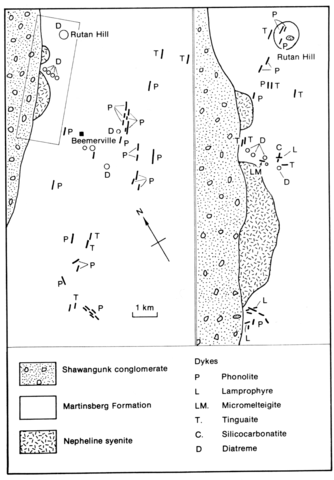stripes
Beemerville is the only complex in the eastern U.S. in which carbonatite has been recognized. It consists of two plugs of nepheline syenite, and dykes and sills of phonolite and tinguaite, micromalignite and micromelteigite, carbonatite and diatremes with xenoliths including autoliths of carbonatite. The alkaline rocks are intruded into the Upper Ordovician Martinsberg Formation of shales and greywackes, but this formation is overlain to the west by the Shawangunk conglomerate, and it is not clear whether the conglomerate post-dates intrusion of the two nepheline syenite plugs. The nepheline syenites are variably granular or porphyritic rocks with phenocrysts of nepheline or orthoclase, together with diopside zoned outwards to aegirine-augite and aegirine, biotite, cancrinite and sodalite, which replace nepheline, melanite and accessories including fluorite. Phonolite dykes up to 50 m wide cut the country rocks, nepheline syenite plugs and diatremes and are generally intensely altered, including albitization and carbonatization. Chemical analyses (Maxey, 1976, Table 2) indicate some of the altered phonolites to be highly potassic (e.g. K2O, 12.02%; Na2O, 0.10%) and others sodic (e.g. K2O, 1.28%; Na2O, 9.25%). Tinguaites have similar field relationships to phonolites, but some occur as sills in the Martinsberg Formation; pseudoleucite occurs in tinguaites cutting the nepheline syenite bodies. Lamprophyric dykes are generally highly altered, but two relatively fresh ones are described by Maxey (1976, p. 1555) as micromalignite, but have a rather similar mineralogy to the phonolites, with phenocrysts of diopside-hedenbergite and biotite in a matrix of nepheline, orthoclase, sphene, melanite and analcime. A single dyke of micromelteigite consists of phenocrysts of diopside-hedenbergite zoned to aegirine-augite in a groundmass of aegirine-augite, biotite, nepheline and accessories. Ocelli of 75% orthoclase and 25% nepheline are a characteristic feature of the lamprophyres, except that in the micromelteigite dyke they are of carbonate. The diatremes are choked with country rock xenoliths, but also include blocks of nepheline syenite, lamprophyre and carbonatite. The largest diatreme at Rutan Hill is intruded by a small plug of nepheline syenite. Carbonatite forms a body, probably a dyke, of 2x8 m between the two main nepheline syenite bodies. It consists of calcite, biotite, apatite and a little magnetite, pyrite and albite. A range of chemical analyses of all rock types is given by Maxey (1976).
MAXEY, L.R. 1976. Petrology and geochemistry of the Beemerville carbonatite-alkalic rock complex, New Jersey. Bulletin of the Geological Society of America, 87: 1551-9.
ZARTMAN, R.E., BROCK, M.R., HEYL, A.V. and THOMAS, H.H. 1967. K-Ar and Rb-Sr ages of some alkalic intrusive rocks from central and eastern United States. American Journal of Science, 265: 848-70

